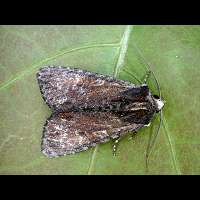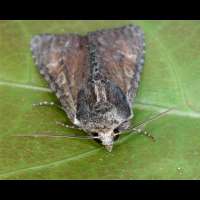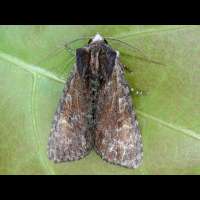Clouded-bordered Brindle Apamea crenata
In Dutch the Clouded-bordered Brindle is called the Variable Brindle. And the moth really deserves that name. Actually there are two main appearances: a light form and a dark form. The light forms are whitish and have dark yellowish or brownish smears and markings. Look for two brown wedges near the edge of the wing, sometimes with a small brown band, as these are characteristic of the Cloud-bordered Brindle in its standard light appearance. The dark forms (forma combusta) are reddish brown entirely. The kidney mark and the oval are outlined, but the inside usually has the same colour as does the rest of the wing. In these dark forms the shoulder stands out, because they are black usually. So far we have had only one in our garden, which turned out to belong to the dark coloured Clouded-bordered Brindles. The wingspan varies from 36 to 44mm.
The eggs of the Clouded-bordered Brindle hatch in August and the caterpillars start to feed during daytime on the seeds of grasses. They grow slowly though. When the seeds are gone, they move to leaves of grasses, on which they feed by night only. They do not hibernate really, for they are seen feeding on mild winterdays. By the end of March or the beginning of April the caterpillar moves down to the ground and digs a chamber among the roots of the foodplant in which it pupates. Fresh adult moths appear after some ten weeks. The larva is greyish, sometimes with a hint of pink and has a narrow and pale dorsal line. The head is dark brown, the pinacula are black, but very small. Under them runs a very thin line and under the line the caterpillar is of a lighter colour. Just under the pinacula in the lighter area are two small black dots. The larvae feed on Cock's Foot mainly, but are found on other grasses as well and on other plants occasionally. The caterpillars will reach a length of some 36mm.
The Clouded-Bordered Brindle is on the wing from the end of May to the end of June, sometimes seen in July, but in small numbers only. It actively visits garden flowers in dusk. Is also attracted to light. This species is not confined to just one habitat and is widespread all through the British Isles. Widespread and often common on the continent as well.
In Dutch the Clouded-bordered Brindle is called the Variable Brindle. And the moth really deserves that name. Actually there are two main appearances: a light form and a dark form. The light forms are whitish and have dark yellowish or brownish smears and markings. Look for two brown wedges near the edge of the wing, sometimes with a small brown band, as these are characteristic of the Cloud-bordered Brindle in its standard light appearance. The dark forms (forma combusta) are reddish brown entirely. The kidney mark and the oval are outlined, but the inside usually has the same colour as does the rest of the wing. In these dark forms the shoulder stands out, because they are black usually. So far we have had only one in our garden, which turned out to belong to the dark coloured Clouded-bordered Brindles. The wingspan varies from 36 to 44mm.
The eggs of the Clouded-bordered Brindle hatch in August and the caterpillars start to feed during daytime on the seeds of grasses. They grow slowly though. When the seeds are gone, they move to leaves of grasses, on which they feed by night only. They do not hibernate really, for they are seen feeding on mild winterdays. By the end of March or the beginning of April the caterpillar moves down to the ground and digs a chamber among the roots of the foodplant in which it pupates. Fresh adult moths appear after some ten weeks. The larva is greyish, sometimes with a hint of pink and has a narrow and pale dorsal line. The head is dark brown, the pinacula are black, but very small. Under them runs a very thin line and under the line the caterpillar is of a lighter colour. Just under the pinacula in the lighter area are two small black dots. The larvae feed on Cock's Foot mainly, but are found on other grasses as well and on other plants occasionally. The caterpillars will reach a length of some 36mm.
The Clouded-Bordered Brindle is on the wing from the end of May to the end of June, sometimes seen in July, but in small numbers only. It actively visits garden flowers in dusk. Is also attracted to light. This species is not confined to just one habitat and is widespread all through the British Isles. Widespread and often common on the continent as well.






